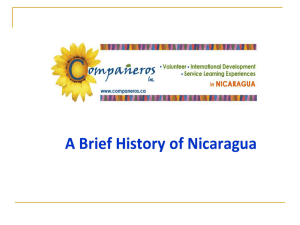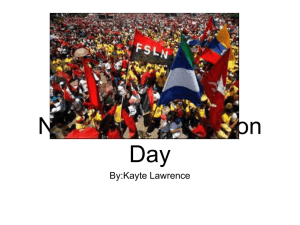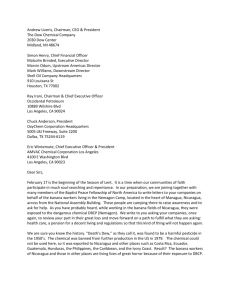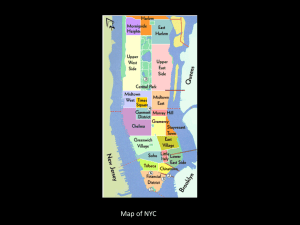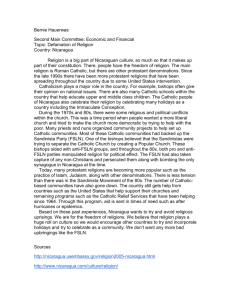Access to Clean Water and Educational Opportunity in Nicaragua Nathan Strauss
advertisement
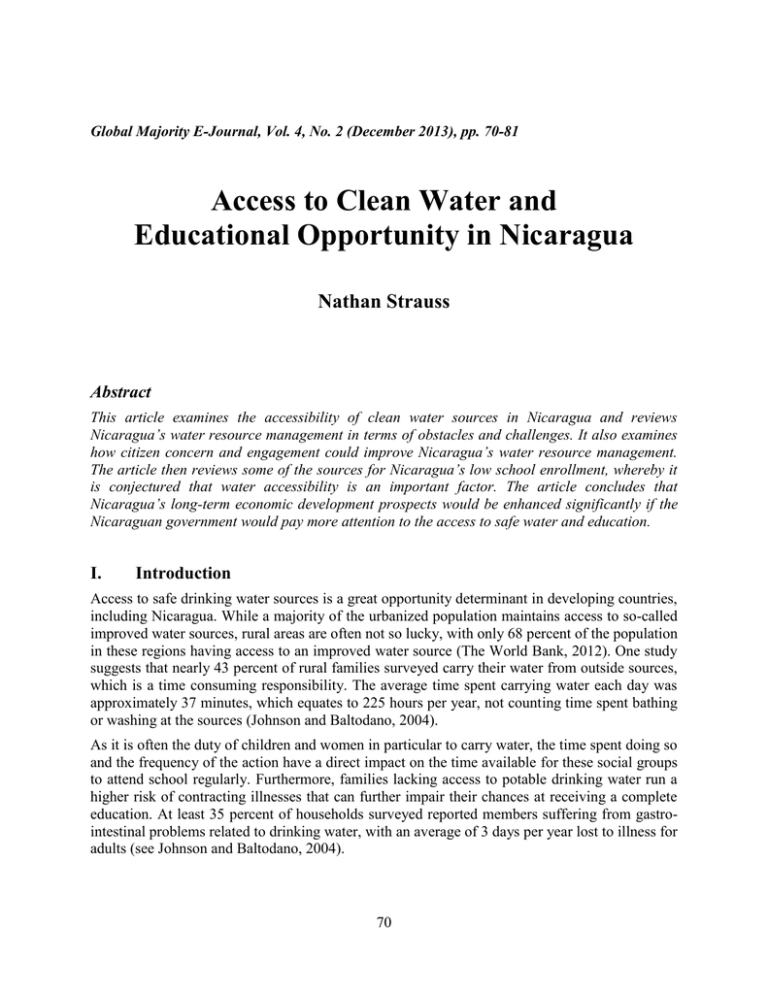
Global Majority E-Journal, Vol. 4, No. 2 (December 2013), pp. 70-81 Access to Clean Water and Educational Opportunity in Nicaragua Nathan Strauss Abstract This article examines the accessibility of clean water sources in Nicaragua and reviews Nicaragua’s water resource management in terms of obstacles and challenges. It also examines how citizen concern and engagement could improve Nicaragua’s water resource management. The article then reviews some of the sources for Nicaragua’s low school enrollment, whereby it is conjectured that water accessibility is an important factor. The article concludes that Nicaragua’s long-term economic development prospects would be enhanced significantly if the Nicaraguan government would pay more attention to the access to safe water and education. I. Introduction Access to safe drinking water sources is a great opportunity determinant in developing countries, including Nicaragua. While a majority of the urbanized population maintains access to so-called improved water sources, rural areas are often not so lucky, with only 68 percent of the population in these regions having access to an improved water source (The World Bank, 2012). One study suggests that nearly 43 percent of rural families surveyed carry their water from outside sources, which is a time consuming responsibility. The average time spent carrying water each day was approximately 37 minutes, which equates to 225 hours per year, not counting time spent bathing or washing at the sources (Johnson and Baltodano, 2004). As it is often the duty of children and women in particular to carry water, the time spent doing so and the frequency of the action have a direct impact on the time available for these social groups to attend school regularly. Furthermore, families lacking access to potable drinking water run a higher risk of contracting illnesses that can further impair their chances at receiving a complete education. At least 35 percent of households surveyed reported members suffering from gastrointestinal problems related to drinking water, with an average of 3 days per year lost to illness for adults (see Johnson and Baltodano, 2004). 70 Moreover, it can be conjectured that direct access to improved water sources within the vicinity of the living space frees up women and children to pursue an education while simultaneously increasing their standard of health. With the ability to take part in an educational system, it is often found that these individuals have more opportunities to leave rural areas and enter the workforce in the hopes of improving their standard of living. In doing so, the subsequent increases in GDP per capita allow for improved economic growth across the country giving it higher standing in the industrialized world. This article examines the willingness of rural communities to engage in projects meant to improve their access to clean water facilities. Furthermore, it details the effects improved access has on educational opportunity for young people, especially women, and how a more advanced education can lead to an enhanced standard of living. This information is presented in a structure that first evaluates the source material, before delving into light analysis of empirical data and then heavier discussion of the primary themes—access to improved water sources and educational opportunity. The concluding section of the document is meant to provide a brief summary of the discussion overall while offering potential insight into improvements meant to better Nicaragua’s socio-economic future. II. Literature Review While not necessarily the most recent data available, the following paragraphs summarize the information presented within a selection of articles that most accurately address the issues presented in this article’s thesis. The publications discussed in the subsequent paragraphs present practical analyses of community concern over water source improvement projects, educational opportunities, and the various factors that can influence opinions on these issues, such as per capita income and regional location. As such, these articles serve as credible sources of supporting material meant to improve arguments in the discussion section that support the thesis statement that improved access to potable water and in turn, more consistent education, raises the standard of living for rural households in Nicaragua. Ahkmouch’s (2012) paper, entitled “Water Governance in Latin America and the Caribbean,” addresses many aspects of water management and allocation in a variety of Latin American countries, including Nicaragua. Figure two in the Nicaragua specific subsection is especially relevant, providing a graph showing obstacles to water management coordination at a central level. As expected, the data seems to imply that lack of political commitment and strategic planning are primary obstacles, while there exists a comparatively high interest in change on the localized level. The paper also details how water is allocated throughout the country, and what bodies exist as mechanisms for coordinating action across various ministries and public agencies. An article by Johnson and Baltodano (2004) presents a comprehensive analysis on the economics of watershed management within the local level, as applied specifically to research done in Nicaragua. Results of the research indicate that on the local level, residents place a relatively modest value on water quality improvement over the course of a year: approximately US$10,000. The data presented on the economics and logistics of watershed management on the local level is both pertinent and easily identifiable, ultimately concluding with the idea that a participatory, multi-sector approach is best for identifying complementarities that can simplify management of complex systems like watersheds. Such information is supported further in a study of the Silvopastoral Project (Pagiola, Rios and Arcenas, 2008), which indicates that even poorer households are willing to participate in paying what they can to improve the quality of 71 their resource management systems. Not only did such households readily participate in Payments for Environmental Services (PES) programs, but in some cases contributed more to improvement initiatives than better-off residences. In addition to understanding what lengths residents are willing to go to in order to improve living conditions and watershed management systems, it is also important to understand the distribution of improved water sources across the region. Such information allows for more precise identification of the variables causing lack of access to such resources, be it a product of poor management or environmental degradation. Such data is accumulated in at least one study (Bain et al., 2012), which also details the various types of facilities utilized in accessing drinking water. The Bain study further breaks down the distribution of potable water into how well it complies with standards of the Millennium Development Goals (MDGs). The issue of resource degradation and its link to poverty is addressed in even greater detail through research conducted by Edward Barbier (2010). The data presented in Barbier holds relevance in its examination of the circumstances of the rural poor, who are often concentrated in less favorable environmental areas, and thus face a greater impact from poor resource management and a hesitancy to engage in PES programs aimed at improving resource access and quality. Beyond this, Barbier (2010) makes the important connection of tying the relationship between resource degradation and poverty to access to outside employment, which allows for a variety of substantive solutions and tradeoffs that can be made on the part of the rural population in an effort to more efficiently control resource usage. In addition to Barbier’s efforts to tie resource degradation to outside employment, Zabaleta (2011) presents a comprehensive analysis of the effects that child labor has on school enrollment and educational attainment in Nicaragua. The largest portion of the data collected in the article presents the consequences of child labor on educational opportunity over time, based on a threeyear longitudinal study of Nicaraguan households. Overall, Zabaleta determines that child labor has a largely negative influence on educational achievement, noting that a regular working day of as little as three hours can have serious negative implications for educational proficiency. III. Empirical Background Nicaragua is the largest country within the Central American Isthmus, having a population of close to six million individuals spread across more than 12,000 square kilometers (World Bank, 2012). Unlike other countries in the region, Nicaragua is recovering relatively well from an intense period of war, and has seen modest growth in its GDP per capita (in real terms) since 1995. However, as Figure 1 shows, Nicaragua’s GDP per capita was in 2010 still far below that of the average developing country in Latin America and the Caribbean (LAC), and the discrepancy has actually become larger within the last decade. In 2010, Nicaragua’s GDP per capita was with US$2,613 (in constant 2005 international $) 200 dollars below that of 1981, while GDP per capita (in constant 2005 international 4) of the average developing country in LAC has increased from about US$7,500 in 1980 to nearly US$10,000 in 2010 (see Figure 1). 72 Figure 1: GDP per capita (PPP-adjusted and in constant 2005$), 1980-2010 Source: Created by author based on World Bank (2012). Despite the disappointing developments in terms of GDP per capita, Figure 2 shows that Nicaragua was able to basically catch up with the average developing country in terms of life expectancy. In 1980, the gap in life expectancy between Nicaragua and LAC was exactly six years, while it was less than half a year in 2010. Figure 2: Life Expectancy at Birth (years), 1980-2010 Source: Created by author based on World Bank (2012). 73 The final statistic we want to look at in the empirical background section is the number of telephone lines per 100 people in Nicaragua and the average developing country in LAC. While the number of telephone lines does not have to be representative to the overall development stage of a country, it provides some indication, especially if looking at developments over time. As Figure 3 shows, Nicaragua seems to fall behind the average developing country in LAC as the gap between Nicaragua and LAC has widened considerably, especially the 1990s. Figure 3: Telephone Lines (per 100 people), 1975-2010 Source: Created by author based on World Bank (2012). IV. Water Access, Water Resource Management and Citizen Engagement IV.1. Access to Safe Water in Nicaragua Figure 4 depicts the disparities in potable water access between urban and rural populations. As to be expected, a much lower percentage of rural populations have access to these water sources than individuals living in urban areas. In 2010, 68 percent of the population in rural areas had access to safe water, compared to nearly 100 percent in urban areas. Without direct access to improved water sources, many rural populations face arduous walks to collect water that may after all still be contaminated, resulting in health issues and potentially harmful absences from work and/or school. 74 Figure 4: Access to Safe Water for Rural and Urban Populations (percent), 1990-2010 Source: Created by author based on World Bank (2012). IV.2. Water Resource Management One of the most important determining factors in how water access is allocated nationally is resource management, which in Nicaragua is controlled through a network of government agencies. As reported in Ahkmouch (2012), in Nicaragua, these organizations include primarily the Ministry of Environment and Natural Resources (MARENA), National Authority of Water (ANA), Aqueducts and Sewer Systems National Institute (INAA), Aqueducts and Sewer Systems National Company (ENACAL), Ministry of Agriculture and Forests (MAGFOR), and the Ministry of Health (MINSA). The allocation for uses of water resources is primarily managed in Nicaragua by MARENA, MAGFOR, INAA and ENACAL, while water quality is managed solely by MARENA and INAA. Water allocation is further divided into three sectors, either for domestic, agricultural, or industrial usage; these sectors are even further managed by one or more of these specific agencies. Despite the prevalence of this handful of government agencies, it should also be noted that there is not a central agency for addressing water related issues, nor is there an inter-ministerial mechanism for addressing territorial water concerns (Ahkmouch, 2012). Without such central bodies in place, the network of management agencies is difficult to navigate and can cause a variety of issues in legislating water usage and forming national policies on the matter. Figure 5 shows the main obstacles to horizontal coordination in water policy making in Nicaragua. Furthermore, Figure 6 provides a detailed list of the many obstacles in creating effective water policy in Nicaragua, as well as the degree of impact that each issue has on the issue overall. Were many of these issues to be tackled by the national government, improved water access would likely become available to a broader spectrum of Nicaragua’s population. It is important to note, however, that such change is not solely the duty of the Nicaraguan government—it is 75 also the duty of the citizens to negotiate policy with their legislators and work to create the most effective system for addressing their circumstances. Citizens, too, must be aware of the benefits that come from improved resource management and water allocation policy. A lack of awareness of potential health benefits, among other things, can be largely detrimental towards encouraging popular support for resource management legislation (Johnson and Baltodano, 2004). Figure 5: Main Obstacles to Horizontal Coordination in Water Policy Making Source: Ahkmouch (2012), p. 132. Figure 6: Main Remaining Challenges in Nicaragua’s Water Policy-Making Source: Ahkmouch (2012), p. 136. 76 IV.3. Citizen Concern and Engagement In order for the Nicaraguan government to effectively institute policies to better manage water resources, the communities in need of assistance must demonstrate concern over the issue and a willingness to become involved in the policy making process. Furthermore, the degree to which different rural communities value water access is determined by the different purposes for which it is utilized. For some communities, water access is important agriculturally and potable water is available for consumption; in others, potable water may be unavailable, and as such, becomes the primary concern. Johnson and Baltodano’s study focuses largely on water valuation in terms of domestic consumption. As a result, the data presented in the study portrays several communities’ commitments to securing improved water sources for use in drinking, cooking and bathing and may not be as precise as data collected based on water as an input into a production process, like agriculture (Johnson and Baltodano, 2004). The data collected in Johnson and Baltodano’s study indicates that the success of potable water projects are contingent upon cost and the behavior of the community. The study found that in some cases improved water sources were not properly maintained by the community or were not used at all for one reason or another. Effectively, this nullified a previous rule of thumb that dictated that as long as the costs of a water source project did not exceed 5 percent of household income, most households held positive interest in securing water from the project. Rather, the data accumulated by the study would seem to indicate that a better understanding of household demand for water may be needed and could be contingent on community preferences (Johnson and Baltodano, 2004). In one aspect of the Johnson and Baltodano study, citizens in the rural community of San Dionisio were surveyed on their willingness to pay for improved water sources. Respondents were asked the following: “Imagine that it were possible to improve your most frequently used water source, be it potable water, well, spring, stream or river. Improving the source means that there would be more water of better quality from the same source. Think about how much it would be worth to you to have water from this source.”1 In addition, respondents were then asked if they would be willing to pay a declining series of monthly payments starting at US$1.43. The combination of questions had strength in that it effectively covered the definition of a potable water project while evaluating to what extent a community would be willing to pay towards gaining one or improving their current system. As a result of the survey, it was determined that on average, households in the San Dionisio community were willing to pay US$0.38 a month to improve their water system, or approximately 0.61 percent of their annual income. Conversely, communities where a traditional water source was already available, such as a well or water pump, households were often not willing to pay more than 1 percent of their annual income towards improvement (Johnson and Baltodano, 2004). While this study merely presents data on a selection of rural communities in Nicaragua, it provides a useful example in determining to what lengths a typical community will go to improve their water utilities. Essentially, it can be surmised that it is the communities with the least or most inaccessible water 1 Johnson and Baltodano (2004), p. 64. 77 sources that are willing to fully endorse policies to improve water systems. Other communities are partial to improvement, but contingent upon the cost of the program. In fact, Johnson and Baltodano (2004) go so far as to claim that poorer households will nearly always be willing to pay less than richer households. While this may be true in the case of the localities examined in the study, data presented in Barbier’s study may refute that notion. Barbier (2010) notes the inextricable linkage between environmental preservation/resource sustainability and the livelihoods of the rural poor. Moreover, Barbier discusses the notion that, contrary to Johnson and Baltodano’s research, the sheer importance of natural resources, like potable water sources, is enough to encourage most communities to invest greatly in their management and eventual improvement. Contrary to popular belief, Barbier argues that environmental degradation is not a result of the actions of the poor, and that poor communities are in fact especially mindful of their resources when given the opportunity. The commonly held idea of a “poverty-environment trap” that involves poverty stricken households degrading the environment to make a living, while subsequently furthering their poverty through said degradation, must be revised in light of a more complex relationship between impoverished communities and the environment (Barbier, 2010). V. Educational Access and Opportunity Many families require the assistance of their children in helping to manage their property and family resources. In the case of boys and young men, they are needed to assist their fathers in tending crops and maintain the property; girls and young women are often needed at home to accomplish domestic tasks, including the fetching of water, which can be extremely time consuming. Because of these responsibilities at home, school enrollment rates following completion of primary school in Nicaragua are relatively low overall (see Figure 7). Figure 7: Primary and Secondary School Enrollment (gross, percent), 1970-2010 Source: Created by author based on World Bank (2012). 78 As of 2010, net secondary school enrollment for the country was at approximately 45 percent, which is quite low though a significant improvement from the nearly 35 percent it was in 1990. Figure 7 shows the progress made in gross primary and gross secondary school enrollment from 1970 to 2010. While net enrollment is clearly a better indicator of progress than gross enrollment, Figure 7 shows the developments for gross enrollment as data on net enrollment is only available for the last few years. It can be conjectured that with increased urban population growth, and in turn, increased access to improved water sources, further progress in school enrollment ratio can be expected in the coming years, even though the trend of the last few years has shown some stagnation. Despite some economic growth and improvement in school enrollment (shown, respectively, in Figures 1 and 7 above), Nicaragua faces a drastic deficit in educational enrollment when compared to Latin America and the Caribbean. As seen in Table 1, only 44 percent of Nicaraguan children who start primary school are able to complete it in the typical six years. This is the worst figure in Latin America, including if comparing Nicaragua to countries with similar levels of economic development like El Salvador, Honduras, and Guatemala (Zabaleta, 2011). Enrollment rates for secondary education are similarly low—and fall far short of the average for Latin America as a whole, which settles at approximately 72 percent. When considering this data, one must also take into account the fact that children who have already entered the work force are significantly less likely to pursue a consistent education than children who are not working. Approximately 60 percent of working students will pursue an education, as opposed to 80 percent of non-working students (Zabaleta, 2011). It is, however, important to realize that while school enrollment percentages allow us to conjecture as to the true educational achievement of a country’s youth, they are not conclusive and there are cases in which young people are able to effectively balance both work and study. Table 1: Net Enrollment Rates in Primary and Secondary Education and Survival to Last Grade of Primary Education in Selected Countries of LAC Source: Zabaleta (2011), Table 1 (based on UNESCO data). 79 The research conducted in Zabaleta’s study ultimately indicates that the longer a student works, the more they must make a trade-off with schooling, essentially sacrificing one for the other. In many cases, students are forced to sacrifice school for work and eventually suffer failure in school further down the line, be it through repetition of a grade or ending of schooling all together. As a result of this cause-and-effect scenario, these children enter adulthood having had less schooling than their peers and, as such, face a distinct disadvantage in earning potential over the course of their futures (Zabaleta, 2011). In fact, the currently held belief is that the educational threshold to achieve an acceptable standard of living in Latin America is completion of secondary school—a requirement that Nicaragua has great difficulty meeting, having among the lowest secondary school enrollment rates in the region. While enrollment rates vary by year, in all cases evidence seems to suggest that the more hours worked, the lower the rates become; rural students that must assist their families in necessary functions of living, such as domestic work and farming, or who must help augment their family’s income through other work face a distinct handicap in reaching completion of secondary schooling, let alone primary school (Zabaleta, 2011). VI. Conclusion Access to improved water sources, as well as the opportunity to pursue an education, has an enormous impact on the living standards of the global majority, and Nicaragua is no exception. As evidenced by the data discussed in the main body of the research, both issues require significant involvement on the part of the Nicaraguan government to provide better public services aimed at improving the circumstances surrounding both of these issues. Access to clean water in particular could be argued to be the root of the dilemma as a whole. Without immediate access to clean water, people must expend time carrying water from a further source or face the risk of illness from contamination. Both of these problems are detrimental to work and education. Time spent carrying water could be used for either, while a sick individual becomes unable to attend school or work. Furthermore, lack of access to clean water contributes to the “poverty-environment” trap that complicates the livelihoods of rural communities in a number of developing countries, including Nicaragua. There are several ways in which global efforts can assist in improving the living standards in Nicaragua. For instance, increased funding to PES projects creates incentive for rural communities to maintain the environment and avoid the path towards the “poverty-environment” trap discussed by Barbier. Moreover, a prevalence of PES projects increases community participation and creates job opportunities that may not exist otherwise. Beyond this, targeting funding directly at improving the living standards of the poor may be effective as well. International aid for the development of improved water sources or for scholarships to encourage school enrollment could both help drastically in improving the opportunities presented to a new generation in the Nicaraguan work force. If Nicaragua is to improve its economic status and create a higher standard of living for its citizens, one of its primary concerns must be strengthening support to organizations and government agencies that works towards regulating child labor and ensuring that children in rural areas are able to attend school regularly. Only once these public services are provided by the government can the rural community began to put effort into its education and strive for a more developed standard of living and higher per capita GDP. 80 References Ahkmouch, Aziz (2012). Water Governance in Latin America and the Caribbean: A Multi-Level Approach. OECD Regional Development Working Papers, No. 2012/04; available at: http://www.oecd.org/gov/regional-policy/50064981.pdf. Bain, Rob E. S.; Stephen W. Gundry; Jim A. Wright; Hong Yang; Steve Pedley; and Jamie K. Bartram. (2010). Accounting for Water Quality in Monitoring Access to Safe Drinkingwater as Part of the Millennium Development Goals: Lessons from Five Countries. Bulletin of the World Health Organization, Vol. 90 pp. 228-235. Barbier, Edward B. (2010). Poverty, Development, and Environment. Environment and Development Economics, Vol. 15, pp. 635-650. Johnson, Nancy L. and María Eugenia Baltodano (2004). The Economics of Community Watershed Management: Some Evidence from Nicaragua. Ecological Economics, Vol. 49, No. 1, pp. 57-71; available at: http://www.opwr.org/edocs/JohnsonBaltodano2004WaterNica.pdf. Pagiola, Stefano; Ana R. Rios; and Agustin Arcenas (2008). Can the Poor Participate in Payments for Environmental Services? Lessons from the Silvopastoral Project in Nicaragua. Environment and Development Economics, Vol. 13, pp. 299-325. World Bank (2012). World Development Indicators / Global Development Finance database Washington, DC: The World Bank); as posted on the World Bank website: http://data.worldbank.org/data-catalog/ (downloaded on May 16, 2012). Zabaleta, Mariela B. (2011). The Impact of Child Labor on Schooling Outcomes in Nicaragua. Economics of Education Review, Vol. 30, No. 6, pp. 1527-1539. 81

